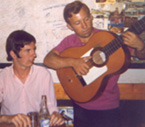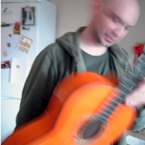Welcome to one of the most active flamenco sites on the Internet. Guests can read most posts but if you want to participate click here to register.
This site is dedicated to the memory of Paco de Lucía, Ron Mitchell, Guy Williams, Linda Elvira, Philip John Lee, Craig Eros, Ben Woods, David Serva and Tom Blackshear who went ahead of us.
We receive 12,200 visitors a month from 200 countries and 1.7 million page impressions a year. To advertise on this site please contact us.
|

|
|
chug! chug!
|
You are logged in as Guest
|
|
Users viewing this topic: none
|
|
Login  | |
|
Guest

|
 RE: chug! chug! (in reply to Ron.M) RE: chug! chug! (in reply to Ron.M)
|
|
|
Ron
Fandangos is defined by its basic palmas, which are xCCxCx repeated. This is the rhythm played to accompany the cante: If you count, it is 1,2,3,4,5,6. The first chord (G7, or A for Fandangos de Almonaster or Calañas) falls on the third beat of this pattern and all other changes on the same beat.
The singer will often sing an extra 6 over any chord and all the guitar has to do is keep playing this rhythm and delay the next change. Sometimes the chord change can be delayed until the 5th beat of the sequence, to accommodate the cante or to offer a little variety, but this is not usual.
Falsetas may maintain this pulse or simply be played in units of 6 or 12, resolving to the typical Am, G, F, E llamada. You will need to learn the whole sequence por medio too.
Suerte
Sean
|
|
|
|
REPORT THIS POST AS INAPPROPRIATE |
Date Oct. 31 2004 10:18:30
 |
|
Guest

|
 RE: chug! chug! (in reply to El Craic) RE: chug! chug! (in reply to El Craic)
|
|
|
If you have problems with compas por Fandangos, try playing Verdiales, which is much more in 3´s: i.e. thumb, rasgeo, rasgeo etc. ad nauseam.
If you have ever listened to Fandangos sung and played by real Onubienses (people from Huelva  , this pattern is used for some styles but the pattern I outlined is used for Alonso and most of Huelva city, probably 80% of what you will hear. , this pattern is used for some styles but the pattern I outlined is used for Alonso and most of Huelva city, probably 80% of what you will hear.
In Huelva a guitarist who specialises in Fandangos is called a guitarrero: everywhere else this means guitar maker. Try listening to Juan Diaz. In Huelva, Fandangos de Huelva is a whole world in itself. If you really want to play it, you will have to go and live there!
Sean
|
|
|
|
REPORT THIS POST AS INAPPROPRIATE |
Date Nov. 1 2004 13:25:35
 |
|
Guest

|
 RE: chug! chug! (in reply to Jim Opfer) RE: chug! chug! (in reply to Jim Opfer)
|
|
|
Hey Ron, the important thing for me was to learn how to tap my foot to the "accented" beat. Regardless of how you count it, for me, I tap my foot once every three beats, and play off of that feel. It is like a waltz, but very slowwwww. I think of it as 6/4: ONE two three, FOUR five six, accenting musically beats "three" and "five", but feeling "one" and "four" very heavy.
But I understand what Jim was saying. Counting it as "one two THREE", etc, helps to overlay this phrase of 12 counts w/ Solea, Alegria, Buleria, etc, where you would feel 3,6,9,12 w/ the foot, but change chord on 2, and accent 4 w/ rasgueao, and the GFE progression would come on 6,7,8, w/ the final strum on 10. That would be an attempt at using the 12 count method to be the one and only way to apply math to flamenco rhythms. But the feel really is just in 3, w/ the repeating accents happening in 6's like Sean said. Starting falsetas on non accented beats are felt like pick up phrases that lead into down beats. Just learn to play off of, with, and around your slow steady foot and you will get it. Learn to accent your phrases on the down beats too. Sevillanas has a similar feeling guitar-wise.
(foot)-E7-Am-(foot)-Am-Am-(foot)-F-E-(foot)-falseta starts-
Looks weird, but learn to keep that foot going and take care w/ what happens in the space between foot taps. Some falsetas may start on a foot tap like this familiar one:
E-------0------------/--0---------------0--/
B-------0------------/--0---------------0--/
G-------1------------/--1-----------0--0--/
D-------2--3-2-0----/--0-----------3-----/
A-2-3-------------4-/------3-2-0---3----/
E--------------------/---------------------/
E----------0-----------0-------------0-----/---------0------------0---------/
B-------------------------------------------/---------------------------------/
G-------------------------------------------/---------------------------------/
D------3----------3-------------3----------/---------------------------------/
A----3-------3-2----------2-0-----------0-/----0-------------0-------------/
E--------------------------------------------/-3----------3-1----------1-0--/
The next bar would be the E chord strum after the foot tap to finish up. So you have to focus on the notes w/ the foot; accenting them helps. Each bar has the foot only once, on the down beat. So that is the first B note, the E7 chord w/ open D string bass, the single 5th str. C note of the alzapua, and the G note on the 6th string of the alzapua. The rest you have to learn to feel in the spaces between taps. Do this for all your falsetas and you will eventually get a natural feel for the phrasing.
Ricardo
|
|
|
|
REPORT THIS POST AS INAPPROPRIATE |
Date Feb. 17 2005 10:45:43
 |
|
 New Messages New Messages |
 No New Messages No New Messages |
 Hot Topic w/ New Messages Hot Topic w/ New Messages |
 Hot Topic w/o New Messages Hot Topic w/o New Messages |
 Locked w/ New Messages Locked w/ New Messages |
 Locked w/o New Messages Locked w/o New Messages |
|
 Post New Thread
Post New Thread
 Reply to Message
Reply to Message
 Post New Poll
Post New Poll
 Submit Vote
Submit Vote
 Delete My Own Post
Delete My Own Post
 Delete My Own Thread
Delete My Own Thread
 Rate Posts
Rate Posts
|
|
|
Forum Software powered by ASP Playground Advanced Edition 2.0.5
Copyright © 2000 - 2003 ASPPlayground.NET |
0.078125 secs.
|


 Printable Version
Printable Version
















 New Messages
New Messages No New Messages
No New Messages Hot Topic w/ New Messages
Hot Topic w/ New Messages Hot Topic w/o New Messages
Hot Topic w/o New Messages Locked w/ New Messages
Locked w/ New Messages Locked w/o New Messages
Locked w/o New Messages Post New Thread
Post New Thread